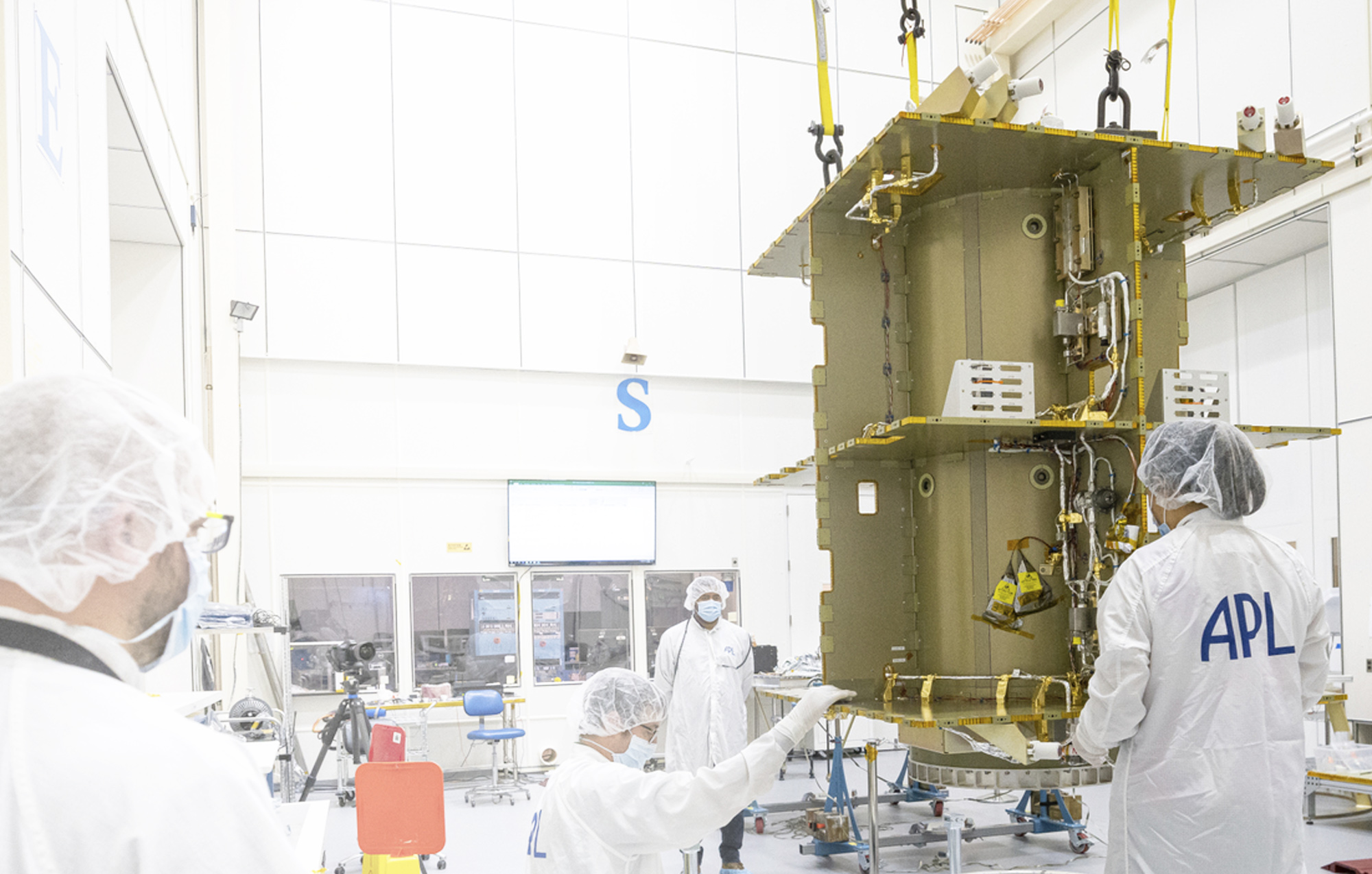Feature Story
Staying Aligned During COVID-19: APL Propels Space Missions Forward
As businesses across Maryland and around the country shuttered or shifted to remote work because of the pandemic, many industries were forced to find a new way forward. While APL adapted remote work to the maximum extent possible, pockets of the Lab — like the Space Exploration Sector — needed to hum along, uninterrupted.
Saturday work on the Laurel, Maryland, campus of the Johns Hopkins Applied Physics Laboratory (APL) isn’t unusual, even under normal circumstances.
But on this this particular Saturday in mid-May — even in the midst of a nationwide pandemic that’s forced most staff members to work remotely — the task at hand couldn’t be relegated to a Zoom call, nor could it wait until Monday morning. The primary structure for a spacecraft was arriving after a cross-country road trip, and it needed immediate unpacking.
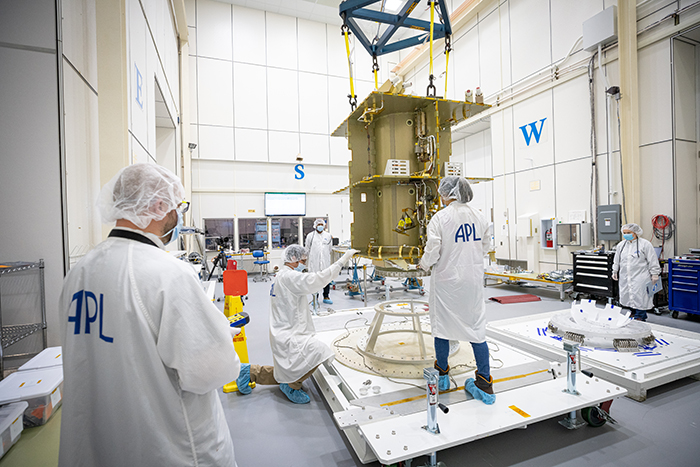
Photo credit: NASA/Johns Hopkins APL/Ed Whitman
Donning the attire for such a job — including lab coats, booties, gloves, hair coverings and, now, face masks — a handful of engineers in APL’s Space Exploration Sector (SES) meticulously unboxed and moved the refrigerator-sized structure of NASA’s Double Asteroid Redirection Test (DART) spacecraft to a clean room, where it will come together over the next several months and undergo rigorous testing in preparation for its launch to impact an asteroid in 2021.
Unboxing a spacecraft is an arduous task, made even more so with protective measures for COVID-19. The group took care to remain at least six feet apart at all times and minimize the number of people working together at once inside the cavernous clean room. Large as it may be, the room can feel small when work necessitates hovering over shoulders, and a delicate job becomes all the more nerve-wracking with unavoidable, close-proximity, hands-on adjustments.
But heightened awareness and vigilance — while continuing to deliver critical work on time — have become the APL norm during the months after COVID-19 arrived.
As businesses across Maryland and around the country shuttered or shifted to remote work because of the pandemic, many industries were forced to find a new way forward. While the Laboratory adapted remote work to the maximum extent possible, pockets of APL — like the Space Exploration Sector — needed to hum along, uninterrupted.
As the pandemic stretches on and the state cautiously reopens, APL staff members remain uniquely focused on hitting their targets. In an unprecedented situation, these teams are evolving and adapting to ensure the quality of Lab’s critical work.
The "Hard" Challenge
Jeff Boye and his team were already coming into the Lab at odd hours to test flight hardware for the DART mission when the pandemic began to escalate in early March. Much of the hardware and materials needed for testing were on-site; getting the right people in the right room at the right time suddenly became the big challenge.
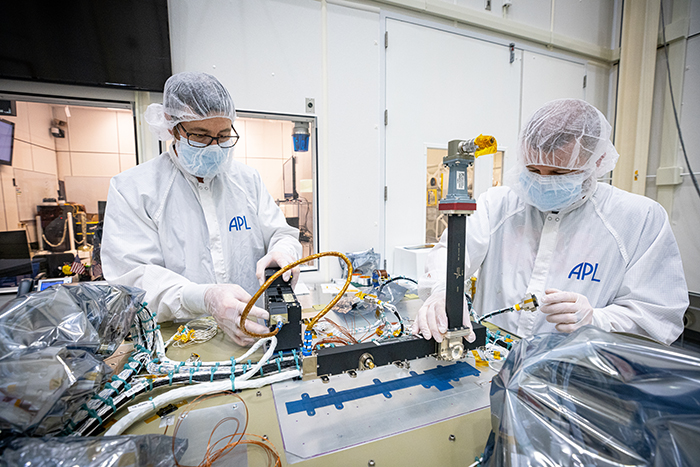
Photo credit: NASA/Johns Hopkins APL/Ed Whitman
“Flight hardware is a team sport,” Boye said, “There are lots of parties involved in bringing flight hardware to bear: design engineers, test engineers, manufacturing, quality control and more.”
As the Lab began rolling out telework and minimizing on-campus operations, Boye, a hardware engineer in SES, and his team rushed to develop a remote, automated system to conduct tests off campus with the right team members. They set up webcams to keep an eye on test equipment and made the footage accessible any time of the day.
While that solution worked, Boye acknowledged that despite regular (virtual) tag-ups, there was an inevitable void that would have usually been filled with organic hallway conversations and off-the-cuff interactions that often yielded critical information and collaboration. “Teaming dynamics have taken a hit — [there’s] the lack of human connection,” he said. “Things go a lot smoother when everyone is involved on the same page.”
On the other side of the country, Juan Morales found himself at the initial epicenter of the U.S. coronavirus outbreak in Washington state, where, incidentally, the DART spacecraft propulsion system integration supplier is located. As a quality engineer and deputy systems assurance manager for the mission in SES, Morales was visiting suppliers to ensure the hardware and components they were building for DART met engineering leads’ specifications.
Though the pandemic was still in its early days, the state began to close down businesses; this in turn impacted the propulsion systems supplier’s manufacturing schedule, extending Morales’ stay.
“I was pretty much stuck in a hotel room for three weeks, only going to the supplier in two- to three-hour increments when they needed me to review paperwork or just do my visual inspections,” Morales said. The timing was terrible. Upon his return to Maryland, he quarantined away from his wife in a rental property owned by the couple, and then prepared to rejoin his colleagues at the Lab.
That timing was better. The integration and testing (I&T) phase on DART — where the spacecraft and its systems come together — was kicking off, pandemic or not.
Time Is of the Essence
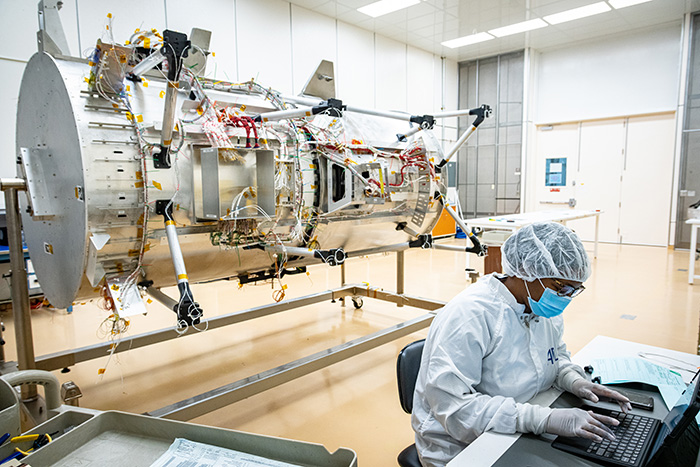
Photo credit: NASA/Johns Hopkins APL/Ed Whitman
Getting a spacecraft to the launchpad is the one big moment that hinges on millions of smaller factors. Funds are often the starting point, followed by labor, the building of various parts and instruments, passing multiple reviews and inspections, and the cooperation of manufacturers, multiple teams and partner organizations, and so forth. All of these factors can arguably be controlled, to a certain extent.
Time cannot.
It can take years to prepare a spacecraft for launch, and many more to get it to its final destination. Schedules, as a result, are tight. Every minute must be accounted for on a mission; the ever-present clock ticking can almost be heard once the spacecraft build begins in earnest.
But it’s the rhythm of celestial bodies that becomes the drumbeat of any mission. Planets orbiting the Sun are factored into a mission’s trajectory — the course that a spacecraft will traverse — with a spacecraft sometimes borrowing a planet’s gravity to speed up or slow itself down. Through this method, a mission can even shave off a few years of travel, if a planet is optimally situated at the right moment.
Our launch windows are literally dictated by just the alignment of planets. There’s no accounting for infectious diseases in Kepler’s laws of planetary motion.
“For deep-space missions, schedule is often the highest priority” said Dipak Srinivasan, APL’s telecommunications systems engineer on NASA’s Europa Clipper mission. “Our launch windows are literally dictated by just the alignment of planets. There’s no accounting for infectious diseases in Kepler’s laws of planetary motion.”
Though still a few years out from launch, Europa Clipper will travel to Jupiter’s moon Europa to explore conditions that could be suitable for life in the ocean theorized to exist under the moon’s icy shell. Led by the Jet Propulsion Laboratory in Southern California, the mission is being developed in partnership with APL, with work split between two coasts. As a result, the APL team members on Europa Clipper have been collaborating remotely with their West Coast counterparts for a few years, and the collective team already had experience with videoconference calling and accomplishing work from multiple locations.
But they still needed to adjust to avoid derailing those carefully planned — and largely out-of-anyone’s-hands — mission schedules.
Making It Work
Jackie Kilheffer’s job is — in her own terms — to keep a mission chugging along.
The quality engineer in SES performs inspections of flight hardware and instruments and oversees tests and other procedures in support of the DART mission. Once a mission begins I&T, she frequently splits time between several buildings and clean rooms on APL’s campus to conduct tests and inspections, often on call.
But keeping the DART mission moving during COVID-19 took on a different format and pace. Kilheffer and her teammates in Space Mission Assurance, Alexie Hoyle, Catherine Shelton and Morales, quickly revamped their schedules to minimize travel between buildings and cut back on the amount of time they spent on campus, and with each other.
“Usually we are here all day to support whatever task is asked of us from the DART leads,” Kilheffer said. The trio instead split up and were assigned to specific labs and buildings, and required two hours’ notice of when they would be needed on-site, versus the normal 30-minute heads-up they typically receive.
“When we do come in for on-site activities, we are practicing a ‘get in and get out’ method,” Kilheffer explained. “We do not hang around after tests or go to our offices; once the task is complete, we leave.”
When you physically have to be around flight hardware, it’s nearly impossible [to fully social distance].
As quality engineers, the group makes sure hardware and people are safe during I&T. It’s a physical role, with hands-on work and close interactions — made more challenging by social distancing and worries of COVID-19.
“When you physically have to be around flight hardware, it’s nearly impossible [to fully social distance],” Hoyle said. “We go through the drawing and the specifications and observe where everything was installed. We inspect hardware for any damage, move flight hardware to the [vibration] table and be there when it gets moved back [to the clean room].”
The team also pays attention to the less obvious details, like making sure there are no trip hazards during the delicate process of moving hardware and spacecraft components, checking that everyone is plugged in to electrostatic discharge monitors, and using calibrated tools and equipment.
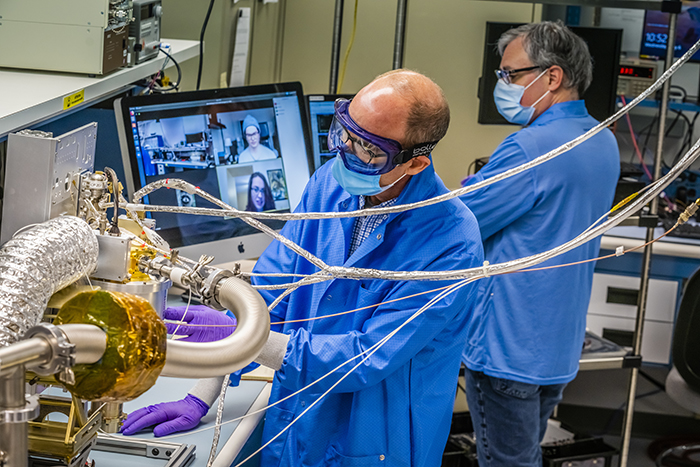
Photo credit: Johns Hopkins APL/Craig Weiman
“This can be stressful, but we ensure we are wearing proper [personal protective equipment],” Kilheffer said. “It’s just the nature of the I&T process; you need all the hands you can get to move equipment or parts, and to ensure everything is safe and in place before you begin.”
Some can avoid being confined to a small space. The team working on the Gamma Ray and Neutron Spectrometer (GRNS) instrument for the Psyche mission, for example, has turned to remote options and the bare minimum of direct on-site work. The GRNS instrument is being built at APL and will launch aboard Psyche in 2022 to measure and map the asteroid Psyche’s elemental composition.
The GRNS team moved the majority of its work to Zoom, which has made team members surprisingly more efficient and allowed them to multitask in a new way. They whittled operations down to one or two staff members on campus, once or twice a week. Lead engineer John Goldsten and electronics lead Samuel Fix worked together on campus one day, maintaining the requisite six feet apart in their lab, while they focused on the engineering model in front of them. A monitor nearby displayed several team members on a Zoom call, as well as source code, which saved them the extra step of having to go back to their desks for the information.
The team still has to do GRNS’ sensor assembly on-site, but the ability to perform tasks remotely is invaluable as they continue critical work.
“The results on the instrument’s performance are really good,” said David Lawrence, the SES scientist leading the development on GRNS. “It’s better than expected, even more so under the circumstances.”
Beyond Space
The handful of technicians in the lab space that houses the Research and Exploratory Development Department’s electrical assembly team build computer boards. Their work touches everything from spacecraft and submarines to defense systems and prosthetics.
“We can’t do that from home; we have to be here,” explained Kim Gerhardt, who as team technical support focuses on the planning and parts process. When she receives a kit — parts from engineers or stock rooms, for example — she verifies the paperwork and the build request. Once she creates a work order and gets it on the floor, she’ll track parts and progress.
“When things ramp up for Space Exploration, it increases for us [as well],” she said. Gerhardt and her colleagues, while not directly involved in space missions, are working on DART, Europa Clipper and Psyche.
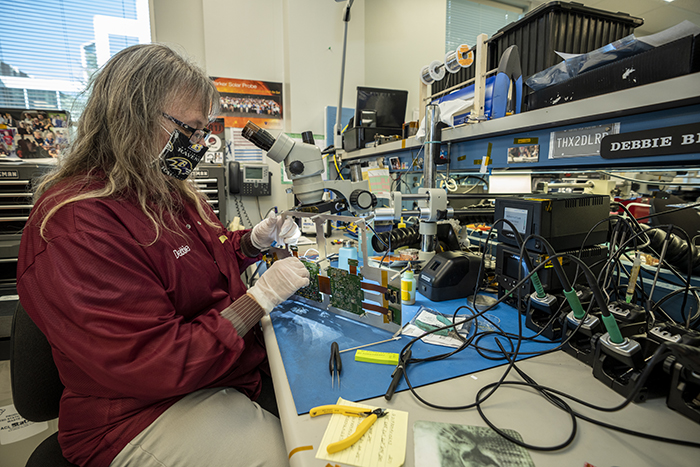
Photo credit: Johns Hopkins APL/Craig Weiman
Normally, assembly work requires interacting closely with the engineer involved on the product. In the pandemic-altered world, the team has limited access to their assembly lab and aims to do most of their collaboration over the phone or via email.
“Sometimes face-to-face is better,” admitted Debbie Berg, a technician in the flight lab. “Some things they have to look at and see to understand a particular problem,” which is most challenging for the very hands-on team.
To stay safe on-site, face masks are routine, and technicians also wear gloves when they handle materials. Several times a day, they wipe down surfaces, benches, bags and more, keeping a steady supply of wipes and spray to sanitize their areas and materials. The team is currently working four 10-hour days, taking either a Monday or Friday off. Berg looks at the modified schedule as a silver lining during the unique situation.
“I have been here 18 years and this is a first, so we are all trying our best to muddle through it,” she said. “It is critical that we keep the assemblies moving in order to meet our deadlines. I feel blessed that I am considered an essential employee and that APL can keep us working safely here at the Lab.”
If it wasn’t COVID-19, it could have been something else. If we stick together and do our own part, we help everyone else out [at the Lab].
Team members have spread out onto two floors to create more distance among them and to minimize contact with the few staff members who know where they are. There’s even a tape measure on hand to ensure everyone maintains the six-foot distance when in close proximity.
Safety is of elevated import to Gerhardt, who is 35 weeks pregnant with her first child. She appreciates the extra precautions her team is taking to maintain a safe environment.
“If it wasn’t COVID-19, it could have been something else,” she pointed out. “If we stick together and do our own part, we help everyone else out [at the Lab]. My coworkers are doing just that; they are very aware, and everyone just knows to keep a distance and ‘give Kim even more space.’ We’re kind of a family down here. And you keep your family safe.”
The Way Forward
The staff members who work on-site emphasized how critical communication has been in forging ahead. The DART team talks frequently to ensure that someone is always available on campus, while the rest juggle personal lives that have also been upended.
“We all have families at home, so we communicate daily on what’s going on with our home life so that we all don’t feel the pressure of being on-site all the time,” Kilheffer said, noting she’s relearning sixth-grade chemistry and third-grade math while homeschooling her children. “Effective communication between the DART SMA team has been the biggest success so far.”
“My kids have been amazing these past two months — I think sometimes we forget everything that these young kids are going through. No school, no friends, no sports or activities, they can’t see their family — but the only complaint I have heard from them is that they are tired of jumping on the trampoline … or hungry,” she joked.
Hoyle has two children under the age of 5.
“We are lucky that they are not in grade school yet and are not required to submit official schoolwork. My son is about the enter kindergarten next year and we want him to continue on with his learning, which is difficult while working full-time,” she said. More chores have materialized at home now that her family is spending more time there. “I have to cook breakfast, lunch and dinner, and I didn’t have to do that before!”
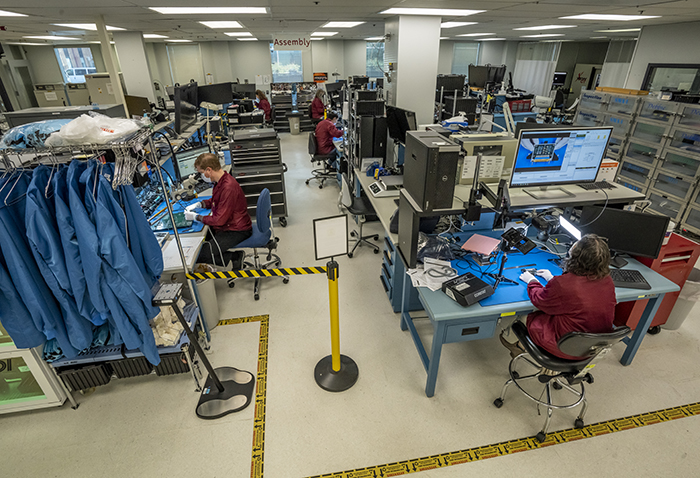
Photo credit: Johns Hopkins APL/Craig Weiman
Change and sacrifice are hallmarks of the work these APL staff members are doing. Shelton, currently in graduate school, chose to drop a course partly because her DART schedule was picking up. She would’ve preferred to forge on, but the unknowns created by the evolving pandemic and lack of extra time in the DART mission made it a no-brainer.
“Our group [mission assurance] is ultimately responsible if something goes wrong,” said Shelton. “There’s a little more worry on my back, but I am proud to hold that responsibility regardless of what’s going on in the world.”
The pace only continues to increase on DART. Launch is a little more than a year away. With the spacecraft’s DRACO imager successfully completing environmental testing, and radios, guidance and navigation subsystems bench-tested with updated software builds this past May, the mission is firmly on track. The Psyche and Europa Clipper missions are also looking ahead to their next milestones and testing dates.
It’s exciting, if tempered by mixed emotions.
“I’m still getting used to this,” Shelton admitted. “I texted a friend who led I&T on [NASA’s Parker Solar Probe mission]. ‘Does it get easier or do you adapt?’”
Her friend responded, “You adapt.”
